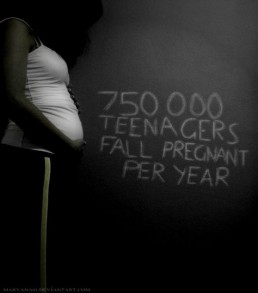Based on the newest teenage pregnancy statistics 2010, teen pregnancy is once again on the rise after decreasing substantially since the early 1990s. According to these new teenage pregnancy statistics for 2010, teen girls ages 15 to 19 are the most likely to get pregnant as a teen.
The overall teenage pregnancy statistics also include the total number of pregnancies that are carried to full term and delivered as well as the total number of abortions and miscarriages. However, the increase has only risen three percent since 2006, so researchers are unsure if the teenage pregnancy statistics will continue to rise. There are about 40 teenage girls getting pregnant each year out of ever 1,000, according to the teenage pregnancy statistics for 2010.
Why are the teenage pregnancy statistics starting to rise again?
Researchers from the National Campaign to Prevent Teen and Unplanned Pregnancy are voicing concern over the new statistics. Many are concerned that teens are less likely to use contraception and worried that it is becoming more commonplace to use less reliable methods of birth control like the pull-out method. Because there are so many factors that could be responsible for this increase, it is difficult to tell where the problem is among teens. Some also believe the rise in teenage pregnancy statistics might be in part due to the $150 million per year federal financing for abstinence-only sex education programs. This educational program that is taught in the public school system is designed to only put an emphasis on abstinence from sex and sexual activities until marriage, and avoids any mention of any possible benefits of contraception. However, in light of these findings the federal government under the Obama Administration is moving the focus on sex education to more of a proactive approach, discussing the realities of sexual peer pressure and how to properly use contraception. Sexually Transmitted Disease rates among teens is also on the rise. Organizations like Planned Parenthood and the Guttmacher Institute are convinced these increasing trends are because of the abstinence-only education in schools, and are actively backing this new initiative by the federal government
Who is at risk?
According to the recent teenage pregnancy statistics, the majority of teens that are at risk for becoming pregnant fall into a different, but very specific groups. These include:
- Teens in minority races (blacks and hispanics account for more than half of all pregnant teens.)
- Teens from single parent households
- Teens with a mother who got pregnant as a teen
- Teens from lower class areas or economic backgrounds
The reasons behind many of these new teenage pregnancy statistics result because teens under tough economic conditions or from single parent households are often left to learn about life and sex on their own. They are not taught by a parent to engage in safe sex practices and instead forget or don’t know how to properly use contraception. This plays a huge role in teen pregnancy. Lack of education in all aspects is becoming the biggest problem and contribution to these rising numbers. To help get these numbers lowered and under control, it is important for parents to take an active role in teaching their children about sex and teenage pregnancy as well other sex-related issues like STDs. This is the best way to help prevent more and more teens from getting pregnant unintentionally.
The costs of teengage pregnancy are costing tax payers throughout the United States about $10.9 billion each year. This number rises as the teenage pregnancy statistics also rise. Not only does having a baby cost the teen parents more than they can often afford, but it ends up costing the nation as a whole. The teens often cannot pay the costs associated with raising a child or even the prenatal care and delivery. This is when the state or federal governments step in and provide the teen with some financial assistance through welfare, medicaid and WIC programs. These programs have to be funded somewhere, with most of the money coming from the tax payers. These reasons are all part of the larger picture as to why educators and parents should take an active role in teaching teens about safe sex.
Sources: nytimes.com, thenationalcampaign.org
